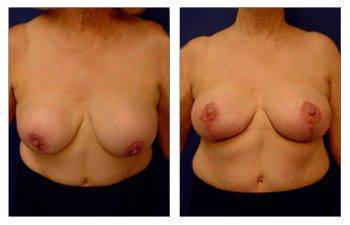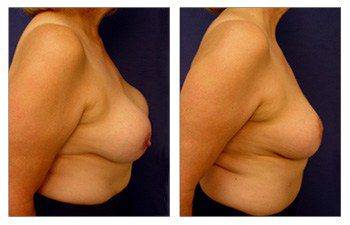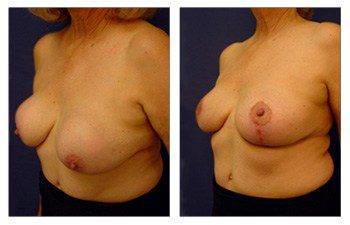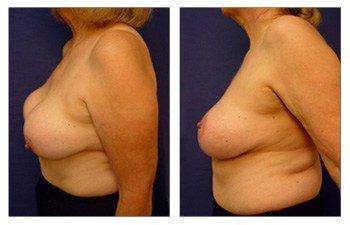





Following breast implant augmentation, some women experience capsular contracture. Capsular contracture is when your breast implant gets scarred up and firmed. Visually, a capsular contracture looks like a stuck-in-place breast implant and the breast mound sagging over it. It is possible to improve this with a Breast lift with implant augmentation to correct capsular contracture. This is also what we call a snoopy deformity. When using silicone implants, the implant gets sticky and may result in this snoopy deformity. In comparison, saline implants will move down with the breast mound and nipple areolar.
A breast lift corrects capsular contracture, and some patients take this opportunity to increase their implant size. When performing a breast lift with breast augmentation to correct capsular contracture, there are two concepts to remember.
a) The first concept pertains to situations where the capsules are not excessively thickened. When dealing with slightly thickened capsules, a surgeon can use them to their advantage when performing a breast lift with implant augmentation.
This can be an advantage to surgeons because, in a breast lift with breast implant surgery to correct capsular contracture, you have to reposition the implants and make room for a larger implant. Suppose the capsules do not exhibit significant thickening. In that case, we can better preserve blood flow, make necessary adjustments to the pocket position, and still utilize the lateral or superior capsule to counteract lateralization.
One example is if the breast lateralizes, you will see the breasts sagging off the chest as you lose the pectoralis area, creating a falling effect of the breasts to the armpit area. In a breast lift revision or a breast lift with implant augmentation to correct capsular contracture, the goal is to centralize and metalize the breasts, sewing the pocket laterally.
Another example arises when implants sag with the breast and areola, requiring a capsulectomy to establish a new chest wall pocket. If the implants become immobile, concerns arise about breast malposition or upward movement. In such instances, we suggest using a breast band.
If you have silicone implants with high breast pockets, the surgeon can strategically employ this method. It retains the superior capsule’s position, preventing the implant from moving upward and eliminating the need for a breast band.
In another scenario, when choosing a larger size, the surgeon must release the previous capsule to create space, requiring a capsulorrhaphy and sometimes a capsulectomy.
b) The second concept is relevant when the capsules become highly thickened to a degree that prevents the breasts from expanding. In this case, your surgeon will have to remove the whole capsule. If this is the case, why not remove the capsule constantly?
The answer is that a somewhat hardened capsule often assists when the skin thins out, potentially exposing the implant. A capsule maintains blood flow to the nipple and possesses vascularity. If it’s possible to preserve the capsule, your surgeon will endeavor to manipulate it rather than remove it, as this is beneficial for maintaining blood flow to the nipple.
A vertical mastopexy is generally employed during a breast lift with implant augmentation. The primary concern is preserving blood flow. This is crucial because back cuts in the procedure can already compromise horizontal blood flow. Additionally, compressing the nipple-areolar area can jeopardize perpendicular or vertical blood flow. Therefore, it is preferable to avoid this risk by retaining the capsule. This careful approach helps ensure the overall success and safety of the surgery.
Correction of capsular contracture with breast lift and implant augmentation requires a board-certified plastic surgeon or cosmetic surgeon, who is an expert in breast surgery. Breast revision surgery will require not only capsular contracture treatment but also implant exchange. Breast augmentation patients must choose between silicone breast implants vs. saline breast implants.
Introduction: Correcting Capsular Contracture with Breast Lift and Implant Augmentation
Capsular contracture is a common complication following breast augmentation surgery. It occurs when the scar tissue that naturally forms around breast implants tightens and contracts, leading to a range of issues, including breast firmness, pain, and distortion. One approach to address capsular contracture is through breast lift and implant augmentation surgery. This essay explores the causes of capsular contracture, the role of breast lift with implant augmentation in its correction, patient considerations, and expected outcomes.
Understanding Capsular Contracture
Capsular contracture is a condition that can develop after breast augmentation, affecting the implants’ appearance and feel. It is primarily characterized by the formation of a tight, constricting capsule of scar tissue around the breast implant. This scar tissue contracture can lead to various issues:
- Breast Firmness: As the capsule tightens, it can cause the breast to feel firm or hard, leading to an unnatural appearance and discomfort.
- Breast Distortion: Capsular contracture can result in visible and palpable deformities of the breast, altering its shape and causing it to appear misshapen.
- Pain and Discomfort: Many individuals with capsular contracture experience pain or discomfort in the affected breast(s).
- Implant Malposition: In some cases, contracture can lead to implant malposition, causing the implant to shift from its original position.
- Implant Rupture: In severe cases, capsular contracture can contribute to implant rupture.
Causes of Capsular Contracture
The exact causes of capsular contracture are not fully understood, but several factors may contribute to its development:
- Bacterial Contamination: Bacterial contamination during surgery or in the implant shell can increase the risk of capsular contracture.
- Hematoma or Seroma: The presence of blood or fluid accumulation around the implant can lead to inflammation and increased contracture risk.
- Silicone Implants: Silicone implants are more prone to developing capsular contracture compared to saline implants.
- Implant Surface Texture: Textured implants are associated with a higher risk of contracture than smooth implants.
- Implant Position: Subglandular (above the muscle) implant placement is more likely to lead to contracture than submuscular (beneath the muscle) placement.
- Autoimmune Response: In some cases, the immune system may play a role in the development of capsular contracture.
Breast Lift with Implant Augmentation for Capsular Contracture Correction
Breast lift with implant augmentation is a surgical procedure that combines two techniques to address breast appearance issues associated with capsular contracture:
- Breast Lift (Mastopexy): The breast lift component aims to reposition and reshape the breast tissue and nipple-areola complex. This helps address the changes in breast appearance caused by capsular contracture and achieves a more natural, youthful breast appearance.
- Breast Implant Augmentation: Implants are used to increase breast volume, providing a fuller and more symmetrical breast shape. The choice of implant size, type, and profile is tailored to the patient’s preferences and individual needs.
The Role of Breast Lift with Implant Augmentation in Capsular Contracture Correction
- Scar Tissue Release:
- The breast lift component of the procedure allows the surgeon to release or excise the tight scar tissue capsule that has formed around the implant. This process helps alleviate the constriction that is characteristic of capsular contracture.
2. Implant Replacement:
- In many cases, the existing implants may need to be removed due to capsular contracture, and new implants are placed during the surgery. This is often an opportunity to select implants that are better suited to the patient’s aesthetic goals.
3. Restoration of Aesthetics:
- Breast lift with implant augmentation not only addresses the physical issues associated with capsular contracture but also aims to restore a natural and aesthetically pleasing breast appearance.
4. Improved Comfort:
- The procedure typically results in reduced breast firmness and discomfort, alleviating the physical discomfort caused by capsular contracture.
Patient Considerations
- Consultation and Evaluation:
- A thorough consultation and evaluation are crucial to assess the extent of capsular contracture, understand the patient’s aesthetic goals, and determine the best course of action. Patients should provide a comprehensive medical history and discuss their concerns.
2. Implant Selection:
- The selection of new implants, if needed, should be a collaborative process between the patient and surgeon. Factors such as implant size, type, and profile are tailored to meet the patient’s desired outcome.
3. Realistic Expectations:
- Patients should have realistic expectations about the outcome of the procedure. While breast lift with implant augmentation can significantly improve the appearance of breasts affected by capsular contracture, it may not completely eliminate all signs of contracture.
4. Surgical Planning:
- The surgeon will develop a personalized surgical plan that may involve the removal of existing implants, scar tissue release, and the placement of new implants. Patients should fully understand the proposed approach and timeline.
5. Postoperative Care:
- Patients must adhere to postoperative care instructions to optimize the healing process and minimize the risk of complications. This may include scar care, implant massage, and activity restrictions.
Expected Outcomes
- Capsular Contracture Correction:
- The primary goal of breast lift with implant augmentation for capsular contracture correction is to release the tight scar tissue capsule and restore the breast’s natural appearance and feel.
2. Enhanced Aesthetics:
- The procedure typically results in an aesthetically pleasing breast appearance, with improved shape, symmetry, and volume.
3. Reduced Discomfort:
- Most patients experience a reduction in breast firmness and discomfort, enhancing their overall quality of life.
4. Improved Implant Positioning:
- If implant malposition was a result of capsular contracture, breast lift with implant augmentation can restore proper implant positioning.
5. Scar Tissue Management:
- While the procedure involves incisions, these incisions are typically strategically placed to minimize their visibility. Scar care and management are essential to help scars fade over time.
Case Studies: Real-World Examples of Capsular Contracture Correction
Case 1: Moderate Capsular Contracture Correction:
- A patient presents with moderate capsular contracture affecting one breast. The surgeon performs breast lift with implant augmentation to release the contracture, replace the existing implant, and achieve an improved breast appearance. The outcome shows a significant reduction in breast firmness and a more natural and symmetrical breast shape.
Case 2: Severe Capsular Contracture Correction:
- In this case, the patient has severe capsular contracture in both breasts, leading to significant breast distortion and discomfort. The surgeon performs breast lift with implant augmentation to release the contracture, remove the existing implants, and replace them with new ones. The result is a dramatic transformation, with the breasts restored to a more natural and aesthetically pleasing appearance.
Here, we present our 58-year-old patient who demonstrates a breast lift with implant augmentation to correct capsular contracture. The patient previously experienced a condition known as “snoopy deformity,” where the implant was positioned high and the breast mound sagged below.
